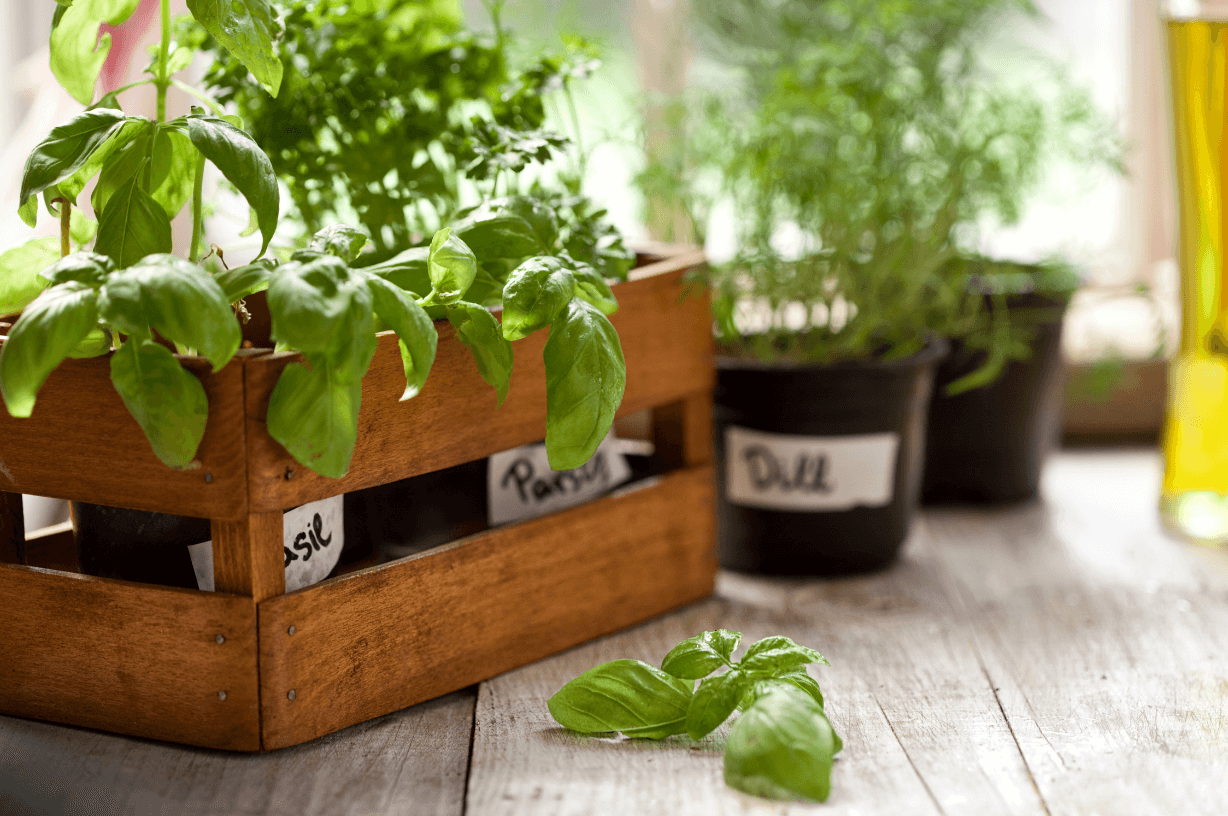Are you ready to add a little more flavor to your life? There’s nothing quite like the burst of freshness that herbs add to your culinary creations – and you don’t have to wait until spring to get started.
With little more than a few pots, some seeds and a sunny window or two, you can have a fresh herb garden right at your fingertips all year long. Let’s start the New Year off right and explore some of the herbs that will thrive indoors:
Basil: The King of Herbs
Humans have cultivated basil for more than 5,000 years, and it’s a staple in soups and stews all over the world. Its vibrant green leaves and distinctive aroma, along with its flexibility of use, make this a “must-have” herb for any cook. Whether you like Italian or Thai, fresh basil is perfect for pestos, salads and oils.
Chives: A Delicate Onion Flavor
Chives are in the same family as onions, scallions and leeks, but they have a more subtle flavor profile when you add them to your dishes. These slender, green stalks are easy to grow indoors with just a moderate amount of sun, and they’re excellent for garnishing and enhancing the taste of soups, salads and omelets.
Mint: A Refreshing Addition
Fresh mint is a wonderful addition to both sweet and savory dishes, and it can also be used to invigorate teas and cocktails. Mint is often used to give meatballs or lamb a bit of Mediterranean flare, but it’s equally delicious in ice cream. Not only does mint help improve digestive health, but its scent is supposed to help reduce stress. There is one caution with mint, however: the herb is very prolific, so always grow it in a separate container.
Rosemary: An Unforgettable Scent
To grow this particular plant indoors, you will need a spot that gets a lot of sun – but rosemary is widely used in all kinds of dishes. When you’re cooking, add it to roasted red meat, potatoes and even homemade bread. Outside of the kitchen, this fragrant herb is also a favorite in soaps and shampoos since it stimulates hair growth and supports the circulatory system.
Parsley: A Neglected Treat
Parsley is very underappreciated these days. It fell out of fashion after it was demoted from a regular addition to cooking pots and lots of dishes to a mere “garnish” in many restaurants, but its fresh, slightly peppery taste can be used to enhance salads, soups and sauces. It also grows beautifully indoors since the plant prefers indirect light.
Thyme: An Earthy Fragrance
Thyme has a subtle, earthy flavor that compliments a variety of dishes, especially poultry, fish and roasted vegetables. It’s also a staple in Mediterranean diets — and a few leaves pack a powerful punch. Thyme is also believed to have both antibacterial and antifungal properties and is considered an antioxidant. It grows well on a windowsill with just moderate sunlight.
Cilantro: A Burst of Freshness
Unless you fall into the subsection of the population with a genetic quirk that makes cilantro taste like soap, you’ll love this bright, bold herb. It’s especially useful if you’re experimenting with stir-fries, salsas or curries, since it is used heavily in recipes from Mexico, India and Southeast Asia. Cilantro is a little harder to grow indoors, but you can do it if you make sure that your plant gets plenty of sunlight and water.
Oregano: A Mediterranean Classic
What’s a meatball or a pasta sauce without oregano, right? Oregano is another staple of Mediterranean cuisine, and it pairs beautifully with tomatoes, olives and grilled meats of all kinds. The best part of this is that growing oregano indoors is fairly easy, and it retains all of its potency even when dried.
Lemongrass: A Bit of Citrusy Elegance
Lemongrass can grow quite tall, so this herb is best grown in a large pot that you can sit on the floor, but it’s incredibly useful in all kinds of Southeast Asian dishes – particularly Thai and Indian dishes. Lemongrass is used in curries, marinades and teas to infuse a dish or hot or cold drink with a fresh lemon flavor that’s absolutely delicious.
Sage: A Flavorful and Medicinal Herb
Sage is more than just an essential part of the Thanksgiving stuffing – it’s often used to season game meat, sausage and roasted root vegetables. Add a little sage to some browned butter, and you also get a perfect sauce for an elegant pasta. Sage grows well indoors with ample sunlight, and a lot of people keep it around to make tea when they have a sore throat since the herb helps fight colds and inflammation.
Lavender: A Culinary Secret
You may think of lavender as something only used for its scent in soaps and potpourri, but culinary-grade lavender has long been used to flavor breads, cookies, cakes and teas. Lavender is also used to relieve headaches, lower anxiety and lift dark moods, which alone makes it worth the effort to grow. Lavender doesn’t like the cold, but it grows beautifully indoors.
Stevia: A Sweet Sugar Substitute
Stevia is a unique herb that can be used as a substitute for white sugar – without all the calories. The leaves can be ground into a fine powder for baking and cooking, and just a few crushed leaves can sweeten your coffee or tea. Stevia plants like well-draining soils and moderate sunlight, and you can harvest the leaves and dry them as needed to keep your plant trimmed to a manageable size.
If you’ve been experimenting with an indoor garden, go ahead and take it to the next level! Cultivating these herbs indoors can provide a constant source of inspiration and freshness to all your culinary endeavors.
amanda.phillips@talktotucker.combill.ingram@talktotucker.combrad.layton@talktotucker.comeditors-pickerina.pribyshchuk@talktotucker.comfeaturedlloyd.zimmerman@talktotucker.commark.callahan@talktotucker.commary.layton@talktotucker.compriscila.hale@talktotucker.comterri.mcgraw@talktotucker.com




